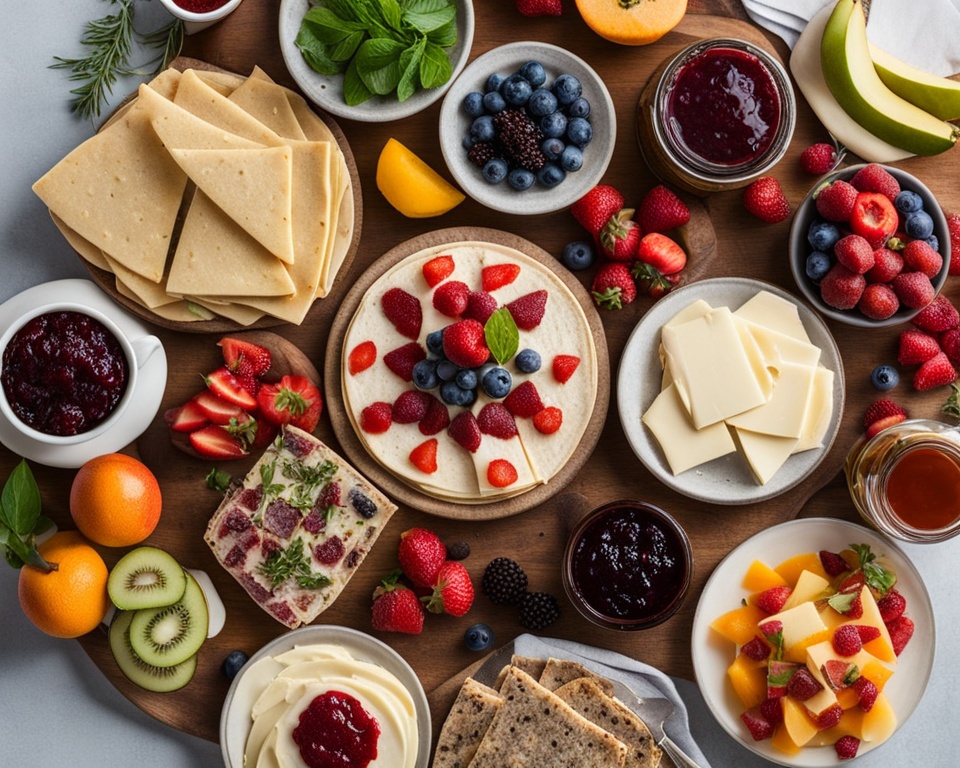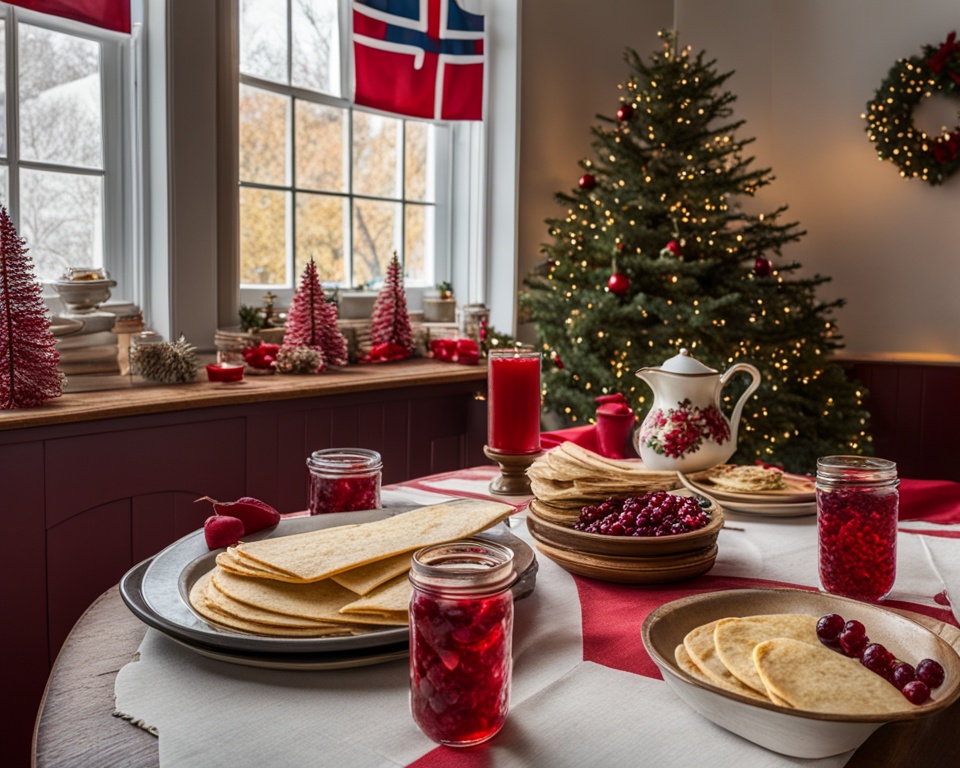In Scandinavia, a special tradition lives on through lefse, a light and tasty Norwegian flatbread. This simple yet charming dish is a big part of the region’s food culture. It’s loved by locals and food lovers all over the world. The story of lefse mixes culture, skill, and the joy of simple things.
Read interesting things at : apportfolioasia
Key Takeaways
- Lefse is a traditional Norwegian flatbread with a rich cultural heritage.
- The recipe and preparation techniques vary across different regions of Scandinavia.
- Lefse is typically made from a potato-based dough and cooked on a specialized griddle or grill.
- Authentic lefse is enjoyed with a variety of toppings and fillings, making it a versatile and delicious treat.
- Mastering the art of lefse making requires skill and patience, but the end result is a rewarding and delightful experience.
What is Lefse?
Lefse is a traditional Norwegian flatbread that has been loved for centuries. It’s made from potatoes and is a key part of Scandinavian food. The Vikings in Norway first made it, showing the area’s deep food culture.
Origins and Significance
Way back when, Norwegian farmers used potatoes as a main food. Making lefse was hard work. Families would come together to mix the dough and cook it on a special griddle.
This flatbread is very important in Norway. It reminds people of farming life and the strength of their ancestors. It’s eaten on special days, like holidays and family get-togethers, where it’s seen as a special treat.
Regional Variations
In Scandinavia, lefse has changed over time to show off local food traditions. Even though it’s made the same way everywhere, different places make their own special kinds of it. You can find thin, delicate lefse by the coast and thicker, more filling kinds inland. This shows how diverse Scandinavian food is.
“Lefse is more than just a simple flatbread; it’s a cultural touchstone that connects generations of Scandinavians to their roots.”
Traditional Lefse Recipe
Lefse, the iconic Norwegian potato-based flatbread, is a treasured dish passed down through generations. It’s made with a classic recipe and a focus on detail. Here, we’ll guide you through making authentic lefse recipe.
- Start by peeling and boiling potatoes until they’re tender. Then, mash them while they’re still warm, letting them cool a bit.
- In a big bowl, mix the mashed potatoes with butter, salt, and a bit of flour. This makes a soft, easy-to-work-with dough. Knead it until it’s smooth and even.
- Break the dough into small balls, like golf balls. Roll each one into a thin, round potato-based flatbread using a lefse rolling pin or a regular one.
- Heat a lefse grill or a big, flat pan to about 400°F (200°C). Put the rolled-out lefse on the hot surface and cook for 1-2 minutes on each side. They should be lightly browned and soft.
- Once cooked, take the lefse off the heat. Stack them on a clean towel or plate, with a paper towel between each one to prevent sticking.
With patience and practice, you’ll soon get the hang of making lefse recipe. You’ll add a delightful touch to your Scandinavian dishes.
| Ingredient | Quantity |
|---|---|
| Potatoes | 5-6 medium |
| Butter | 2 tablespoons |
| Salt | 1 teaspoon |
| All-purpose flour | 1-2 cups |
“Lefse is not just a food, it’s a tradition. Each bite transports you to the heart of Norwegian culture.”
Ingredients for Authentic Lefse
Lefse, a traditional Norwegian flatbread, is made with a special mix of ingredients. These ingredients give it a unique taste and feel. The dough is potato-based, and it’s mixed with butter and flour. Each part is key to making the lefse just right.
Potato-Based Dough
The dough starts with boiled and mashed potatoes. These potatoes make the dough stretchy and easy to roll out. The right mix of potatoes, milk, butter, and salt is important for the best lefse dough.
Butter and Flour
Butter and flour are also crucial for making lefse. Butter adds a creamy taste and makes the lefse soft and flaky. Flour is used to keep the dough from sticking. This makes rolling it out easy.
| Ingredient | Purpose |
|---|---|
| Potatoes | Provide the starch and structure for the dough |
| Butter | Adds richness and a tender, flaky texture |
| Flour | Prevents the dough from sticking during rolling |
“The quality of the ingredients used in lefse-making is paramount, as they directly impact the final product’s taste and texture.”
Lefse: A Potato-Based Flatbread
Lefse is a traditional Scandinavian potato-based flatbread. It’s a key part of the region’s food culture. This bread shows how important potatoes are in traditional Scandinavian cuisine. Unlike other flatbreads, lefse’s dough is made with potatoes, giving it a unique taste and feel.
Potatoes were a big deal in Scandinavian farming and eating. They were grown and eaten a lot, making them a perfect choice for lefse. The potatoes add starch and moisture to the dough. This makes the lefse soft and easy to roll into thin sheets that can be filled with sweet or savory toppings.
“Lefse is more than just a flatbread; it’s a cultural touchstone that reflects the ingenuity and resourcefulness of the Scandinavian people.”
Lefse is more than food; it’s a symbol of Scandinavian culture. Making and sharing lefse brings people together. Families and friends enjoy the process of rolling and cooking it. The smell of fresh lefse takes them back to their heritage.
We’ll now explore the history, different types, and how to make lefse. We’ll see why this potato-based flatbread is so important in traditional Scandinavian cuisine.
Lefse Makers and Rolling Pins
Creating the perfect lefse needs the right tools. The lefse maker and traditional rolling pin are key for this Scandinavian flatbread. They make a big difference in how well it turns out.
Choosing the Right Tools
Choosing the right equipment is crucial for making lefse. A lefse maker, a special griddle, ensures even heating and great results. Lefse rolling pins, often wooden, have a shape that helps roll the dough thinly.
Other important tools include a lefse stick for moving the dough, and a lefse gripper for handling the cooked lefse. These tools, along with traditional methods, make authentic traditional Scandinavian cuisine.
| Tool | Function |
|---|---|
| Lefse Maker | Specialized griddle-like device for cooking lefse |
| Lefse Rolling Pin | Tapered wooden pin for rolling the dough evenly |
| Lefse Stick | Used to transfer the delicate dough to the griddle |
| Lefse Gripper | Helps with handling and folding the cooked lefse |
Getting the right lefse maker and lefse rolling pin is key for making traditional lefse. With these tools and some practice, you can enjoy Norway’s rich flavors in your kitchen.
Cooking Lefse on a Griddle
Mastering the art of cooking lefse on a lefse grill or lefse griddle is key. Getting the temperature and timing right is vital for the perfect texture and consistency. This traditional Norwegian flatbread deserves nothing less.
Temperature and Timing
The ideal temperature for cooking lefse is between 400°F and 425°F (204°C and 218°C). This range helps cook the dough evenly without browning too fast. It’s important to use a lefse griddle or lefse grill that keeps a steady temperature.
Cook each side of the lefse for 30 to 60 seconds. This quick cooking time makes the dough soft and pliable. It prevents it from becoming too crisp or dry. Pay close attention to the timing and flip the lefse at the right moment for the best results.
| Characteristic | Ideal Range |
|---|---|
| Temperature | 400°F – 425°F (204°C – 218°C) |
| Cooking Time per Side | 30 – 60 seconds |
By keeping the right temperature and timing on a lefse grill or lefse griddle, you’ll get the perfect lefse. This beloved Norwegian dish will be a hit with your family and friends.
Lefse Grill vs. Lefse Griddle
Choosing between a lefse grill and a lefse griddle can change how your Norwegian flatbread turns out. Each tool has its own pros and cons. Your choice depends on what texture you want for the lefse and what you like.
The lefse grill is made just for lefse. It has a smooth surface that spreads heat evenly. This makes the dough thin and pliable. It’s easy to use and carry, making it a favorite for many cooks.
The lefse griddle is more flexible, good for many dishes, not just lefse. It might not be as precise as a grill, but with the right touch and heat, it can still make great lefse.
| Lefse Grill | Lefse Griddle |
|---|---|
| Designed specifically for lefse cooking | Versatile for other cooking tasks |
| Provides even heat distribution for thin, pliable texture | May require more skill to achieve desired lefse texture |
| Compact and portable for easy storage and transportation | Larger surface area can handle multiple pieces of lefse at once |
Choosing between a lefse grill and a lefse griddle depends on what you like and need. Both can make tasty traditional Scandinavian cuisine like lefse. But, the grill might give a more traditional lefse texture if that’s what you’re after.
Traditional Scandinavian Cuisine
Scandinavian cuisine is rich and diverse, with dishes passed down through generations. At its core is the lefse, a Norwegian flatbread that’s very important to the culture.
Lefse in Norwegian Culture
Lefse is more than just food in Norway. It’s a key part of the country’s culture and traditions. It’s enjoyed during Christmas and at family meals, bringing people together.
Making lefse is a tradition that involves many generations. They work together to roll, cook, and serve this flatbread. Its unique taste and texture make it a comfort food in Norway.
Lefse also has deep symbolic meaning in Norwegian culture. It’s used for storytelling, with recipes and techniques passed down through the years. Making and sharing lefse helps preserve Scandinavian cuisine’s rich heritage.
Lefse is enjoyed on its own or with toppings. It’s a key part of Scandinavian cuisine. Its popularity shows the strong cultural traditions in Scandinavian food.
Lefse Toppings and Fillings
Lefse, a traditional Norwegian flatbread, is great for many toppings and fillings. You can enjoy it in both savory and sweet ways. Let’s look at how to make your lefse experience even better.
Savory Lefse Toppings
- Butter and salt: A classic pairing that lets the lefse’s flavor stand out.
- Brunost (brown cheese): This sweet and nutty Norwegian cheese is a unique addition.
- Smoked salmon: For a luxurious touch, add silky, smoked salmon on top.
- Bacon and eggs: A filling breakfast option that combines crispy bacon with rich eggs.
Sweet Lefse Fillings
- Cinnamon sugar: A simple mix that highlights the lefse’s warmth.
- Jam or preserves: Fruit jams or preserves add sweetness and color.
- Nutella or chocolate spread: For a rich treat, use creamy Nutella or chocolate.
- Whipped cream and berries: A light and fresh filling that shows off the lefse’s sweetness.
| Lefse Toppings | Lefse Fillings |
|---|---|
| Butter and salt | Cinnamon sugar |
| Brunost (brown cheese) | Jam or preserves |
| Smoked salmon | Nutella or chocolate spread |
| Bacon and eggs | Whipped cream and berries |
Lefse can be enjoyed with savory or sweet toppings and fillings. Its mild taste makes it perfect for many flavors. Try different combinations to find your favorite way to enjoy this traditional scandinavian cuisine.

“The beauty of lefse is that it’s a blank canvas for your culinary creativity. From classic to creative, the possibilities are endless.”
Storing and Freezing Lefse
Keeping traditional Norwegian lefse fresh is key to enjoying this tasty flatbread. Whether you’re storing lefse or freezing lefse, following a few steps is important for keeping lefse fresh.
Keeping Lefse Fresh
To store lefse at room temperature, wrap each piece in a clean, dry paper towel or parchment paper. This absorbs moisture and keeps the lefse from getting soggy. Put the wrapped pieces in an airtight container or a resealable plastic bag. Store them in a cool, dry place. Lefse can last up to 5 days this way.
For longer storage, freezing is best. Let the lefse cool down, then stack it with parchment paper in between. Put the stacked lefse in a freezer-safe bag or container, squeezing out air. Frozen lefse can last up to 6 months, so you can enjoy it all year.
| Storage Method | Shelf Life |
|---|---|
| Room Temperature | Up to 5 days |
| Freezer | Up to 6 months |
To use frozen lefse, thaw it in the fridge overnight or at room temperature for a few hours. Reheat it on a griddle or in the oven to make it warm and soft again. With these easy steps, you can enjoy lefse’s authentic taste even after baking.
Lefse Recipe Variations
The traditional lefse recipe is a classic in traditional Scandinavian cuisine. But, bakers and cooks have made their own versions of this Norwegian flatbread. They’ve added savory and sweet twists, showing how versatile this dish can be.
Savory Lefse Creations
There’s more to lefse recipe variations than just butter and sugar. Here are some savory options:
- Lefse with roasted garlic and herbs
- Lefse wrapped around smoked salmon and cream cheese
- Lefse layered with grilled vegetables and a drizzle of balsamic glaze
Sweet and Indulgent Lefse Twists
For those who love sweets, lefse recipe variations have sweet fillings and toppings. Here are some ideas:
- Lefse filled with a creamy cinnamon-sugar mixture
- Lefse rolled up with a dollop of homemade jam or preserves
- Lefse drizzled with melted chocolate and sprinkled with toasted nuts
| Lefse Recipe Variation | Flavor Profile | Occasion |
|---|---|---|
| Traditional Butter and Sugar | Classic, Sweet | Year-round, Holidays |
| Savory Garlic and Herb | Savory, Aromatic | Casual Gatherings, Appetizers |
| Cinnamon-Sugar Filled | Sweet, Comforting | Dessert, Holiday Celebrations |
These lefse recipe variations show how this traditional Scandinavian cuisine classic can be enjoyed in many ways. Whether you like the traditional or something new, making and sharing lefse is a joy.
Serving Lefse for Special Occasions
Lefse, a traditional Norwegian flatbread, is a key part of Scandinavian celebrations. It’s a must-have during Norwegian holidays, bringing warmth and authenticity to special events.
Norwegian Holidays and Traditions
During the festive season, serving lefse is a cherished tradition in Norway. From Christmas Eve to New Year’s Day, it’s a staple on many tables. It pairs well with a variety of dishes, from stews to sweet treats.
Lefse is also important at other Norwegian celebrations. Norwegian holidays like Syttende Mai and Midsummer Eve highlight its cultural importance. It’s a symbol of tradition and heritage.
| Holiday | Lefse Tradition |
|---|---|
| Christmas Eve | Served with a variety of toppings, such as butter, sugar, or cinnamon |
| Syttende Mai | Enjoyed as a patriotic symbol and part of the celebratory meal |
| Midsummer Eve | Incorporated into the traditional Midsummer feast and celebration |
Serving lefse at these events is more than just eating. It’s a way to connect with Norwegian culture and traditions.

“Lefse is more than just a flatbread – it’s a piece of Norwegian history, a symbol of unity, and a delicious way to celebrate our cultural roots.”
Mastering the Art of Lefse Making
Making the perfect lefse, a traditional Scandinavian flatbread, is an art. It needs patience, practice, and an eye for detail. Whether you’re experienced or new to lefse making, learning key techniques can improve your baking.
Mastering the dough is key in lefse making. The dough is potato-based and must be just right. Kneading and resting the dough are important for the right texture and flexibility.
The rolling and shaping are where you show your skills. Lefse makers use special tools for even thickness and nice browning. Getting the cooking temperature and time right is vital for lefse that’s thin, flexible, and tasty.
Lefse making is more than just baking. It’s tied to traditional Scandinavian cuisine and brings people together. Sharing the process with family and friends creates a bond across generations.
Trying to master lefse making can be rewarding. It lets you enjoy this Scandinavian treat and appreciate its long history. The journey is filled with new discoveries and a deeper love for this simple yet special bread.
Conclusion
Lefse is a beloved Norwegian flatbread that has been a key part of Scandinavian cuisine for many years. It has grown from simple beginnings to a symbol of Norway’s rich food culture.
Learning to make lefse shows the hard work and talent of both experts and home cooks. They use traditional methods to make this special bread. It’s enjoyed with tasty fillings or just with butter and sugar, delighting those who love Nordic flavors.
We invite you to start making lefse yourself and understand its cultural importance. Sharing your lefse with others lets you enjoy its tasty flavors and support traditional Scandinavian cooking. This way, you’ll keep the tradition alive for future generations.



